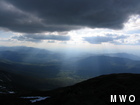DMC
2010-05-24 17:29:20.000 – Mike Carmon, Staff Meteorologist
Crepuscular Rays
With the absence of my counterpart meteorologist this shift, my skills in predicting the unpredictable have been especially on call. Luckily, the presence of a formidable and stubborn ridge of high pressure over the eastern half of the Continental U.S. has provided us with pretty mundane but gorgeous weather for most of the shift. I have lamented with my co-workers that I’m running out of ways to put into words the fact that skies will be sunny and temperatures will be warm. But I should not complain, because before long, some form of wild weather will return with a vengeance, and I’ll be pulling my hair out trying to produce an accurate forecast.
It’s all part of the fun, though. I awoke this afternoon and offered to help Steve out with the afternoon forecast, as it appears conditions will get much more interesting than “in the clear under mostly sunny skies.” A cold front is looming, sneaking in through the back door, and this could give us a shot at a thunderstorm late tomorrow and early tomorrow night.
There are three ingredients a forecaster will look for when trying to predict convective activity (a.k.a. thunderstorms):
1. Instability: An unstable atmosphere is one in which air parcels, when prompted, will become warm enough to obtain buoyancy and rise indefinitely. This is a product of the rate at which the ambient air cools as one ascends through the atmosphere. A rapidly cooling vertical temperature profile coupled with very warm temperatures near the surface provides excellent instability.
2. Moisture: Clouds form when this instability is present and rising parcels cool, permitting the water vapor within them to condense into water droplets. If moisture is lacking, rising parcels of air will do no good.
3. Lift: The first ingredient, instability, contains the caveat “when prompted” in its description. That’s where lift comes in–some form of lifting mechanism needs to be present to provoke parcels contained in an unstable air mass to begin an upward motion. The most common type of lifting mechanisms are boundaries of some kind–cold fronts, warm fronts, dry lines, etc.
Because of the uncharacteristically (possibly record-breaking) warm weather, plenty of instability will build up through the day tomorrow. Copious moisture has been ushered in for days, and with the approach of the cold front, all three ingredients seem to be merging to result in a thunderstorm scenario. Unfortunately, the cold front is quite a weak one, so this has seriously reduced the risk for thunderstorms in the valley. However, orographic lifting (lifting of air as it passes over a mountain) could augment our chances for a few rumbles of thunder. It would be a great way to close out this shift week!
Mike Carmon, Staff Meteorologist
Team Flags Return for Seek the Peak’s 25th Anniversary
Team Flags Return for Seek the Peak's 25th Anniversary By MWOBS Staff Mount Washington Observatory is looking forward to continuing a much-loved tradition for Seek the Peak’s 25th Anniversary: Team flags. In inviting teams
Meet Summer Interns Zakiya, Max and Maddie
Meet Summer Interns Zakiya, Max and Maddie By MWOBS Staff We are excited to welcome six teammates to the summit of Mount Washington this summer! During their internship, these students and graduates will play
Saying Goodbye to the Summit
Saying Goodbye to the Summit By Alexis George After an extraordinary last three years working as a Weather Observer and Meteorologist, I am excited to pursue a different career. As sad I as am






